More than two weeks after indoor dining in British Columbia was once again shut down to help slow the spread of COVID-19, the province has released some data that shows why.
In a presentation Thursday, Provincial Health Officer Dr. Bonnie Henry showed data from the Fraser and Vancouver Coastal health authorities that showed hundreds of new COVID-19 cases acquired in workplaces in February and March were linked to restaurants, bars and lounges.
In the Vancouver Coastal region, employees of dining establishments made up the most workplace cases, with just under 160 cases linked to about 70 different establishments in February and March. Dr. Henry noted that many of these restaurant clusters were linked to Whistler, where transmission has remained high for many weeks.
In the Fraser Health region, about 275 workplace cases were acquired in about 50 different dining establishments between Feb. 1 and April 12. Only industrial/manufacturing workplaces and fitness and gym facilities accounted for more workplace cases in the region.
During these periods, more than 18,000 new COVID-19 cases were identified in the Fraser Health region, while close to 10,000 new cases were identified in the Vancouver Coastal Health region. This means that about 1.5 per cent of the two regions' new cases over this period were acquired in dining facilities.
The province did not release this more detailed workplace data for the other health authorities, including the Interior, despite ordering the closure of all of B.C.'s indoor dining in restaurants.
“The focus of the workplace task group with WorkSafeBC and with the public health teams was on the Lower Mainland, so the data reflects what was collected in Fraser Health and Vancouver Coastal,” Dr. Henry said Thursday.
“So it has not been collected systematically in other parts of the province, but yes it is happening and we know it's happening in the Interior, we're seeing clusters in workplaces, particularly in the urban areas ... that's why things like the indoor dining restrictions apply across the board in the province.”
She noted that the number of workplaces clusters outside of the Lower Mainland are “much smaller,” with the exception of some of the clusters in industrial and mining operations in the Interior and the North.



